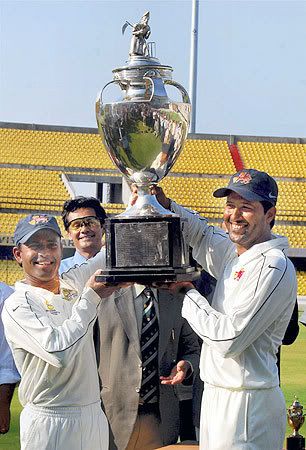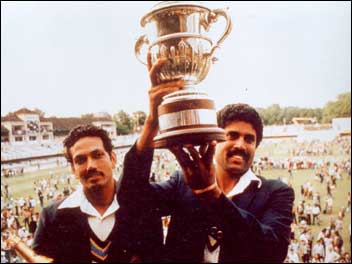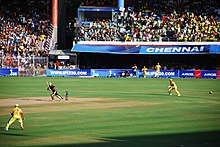Cricket History - Historians have attempted to trace its origin in various ball games played by ancient races and, even if some of these derivations are a little far fetched, we can at least say that 250 years ago the game was being played in a form not so very dissimilar from that of today. Cricket, like Hockey, was brought to the Indian sub-continent by the British. There are references to cricket having being played in India in the early parts of the 18th century. By the beginning of the 19th century the game was being played in the cities of Bombay, Calcutta and Madras.
The presidency matches began in 1892-93 between Parsis and Europeans and the tournament became the Bombay Triangular, with the Hindus fielding a team in 1907-08. In 1912-13, the tournament became quadrangular with the entry of Muslims in the field. With the efforts of several Princes, H E Grant-Gloven and A S de Mellow, the national championship, the Ranji Trophy began in 1935.India played its first official Test against England in 1932. List of First Class Cricket grounds in India
Barabati Stadium, Cuttack Chidambaram Stadium, Chepauk, Madras Chinnaswamy Stadium, Bangalore Eden Gardens, Calcutta Feroz Shah Kotla, Delhi Green Park (Modi Stadium), Kanpur Indira Priyadarshini Stadium, Vishakhapatnam Lal Bahadur Stadium, Hyderabad Moin-ul-Haq Stadium, Patna Moti Bagh Stadium, Baroda Nehru Stadium, Pune Punjab Cricket Association Stadium, Mohali, Chandigarh Roop Singh Stadium, Gwalior Sardar Patel Gujarat Stadium, Motera, Ahmedabad Sawai Mansingh Stadium, Jaipur Vidarbha C.A. Ground, Nagpur Wankhede Stadium, Bombay Achievements
India achived its first 'Cup' victory in international cricket in 1983 when it won the Prudential World cup beating West Indies by 43 runs at Lord's under the captaincy of Kapil Dev. |
Following are the details of India's 'Cup' victories in International Cricket.
Year | Venue | Cricket Championship |
1983 | England | Prudential World Cup |
1984 | Sharjah | Asia Cup |
1985 | Australia | Benson and Hedges World Championship |
1985 | Sharjah | Rothmans Trophy |
1985 | Sharjah | Sharjah Cup |
1988 | Bangladesh | Asia Cup |
1990 | India | Asia Cup |
1993 | India | Hero Cup |
1994 | Sri Lanka | Singer Cup |
1995 | Sharjah | Asia Cup |
India's Test record in cricket against other countries

Based on all Tests up to and including India vs New Zealand in India, 1995-96
Opponent | Date of 1st Test | Tests | Win | Loss | Draw | Tie |
England | June 25, 1932 | 81 | 14 | 31 | 36 | - |
Australia | November 28, 1947 | 50 | 8 | 24 | 17 | 1 |
West Indies | Nov 10 1948 | 64 | 7 | 27 | 30 | - |
Pakistan | October 16, 1952 | 44 | 4 | 7 | 33 | - |
New Zealand | November 19, 1955 | 35 | 13 | 6 | 16 | - |
Sri Lanka | September 17, 1982 | 14 | 7 | 1 | 6 | - |
Zimbabwe | October 18, 1992 | 2 | 1 | - | 1 | - |
South Africa | November 13, 1992 | 4 | - | 1 | 3 | - |
Total |
| 294 | 54 | 97 | 142 | 1 |
Cricket tournaments - Domestic seasons and tournaments
Duleep Trophy - Historical Note

The Duleep Trophy competition was started by the Board of Control for Cricket in India in 1961-62 with the aim of providing a greater competitive edge in domestic cricket - because, apart from the knock-out stages of the Ranji Trophy, that competition proved predictable, with Bombay winning for fifteen consecutive years. The Duleep was also meant to help the selectors in as- sessing form.
The original format was that five teams, drawn from the five zones, play each other on a knock-out basis. From the 1993-94 season, the competition has been converted to a league format.
Ranji Trophy - Historical Note

Founded as 'The Cricket Championship of India' at a meeting of the Board of Control for Cricket in India in July 1934. The first Ranji Trophy fixtures took place in the 1934-35 season. The Trophy was donated by H.H. Sir Bhupendra Singh Mahinder Baha- dur, Maharajah of Patiala in memory of His late Highness Sir Ranjitsinhji Vibhaji of Nawanagar.
In the main the Ranji Trophy is composed of teams representing the states that make up India. As the political states have mul- tiplied, so have cricket teams, but not every state has a team. Some states have more than one cricket team, e.g. Maharashtra and Gujarat. There are also 'odd' teams like Railways, and Services representing the armed forces.
The various teams are grouped into zones - North, West, East, Central and South - and the initial matches are played on a league basis within the zones. The top two (till 1991-92), now top three teams from each zone then play in a national knock-out competition. If the matches are not finished they are decided on the first-innings lead.








